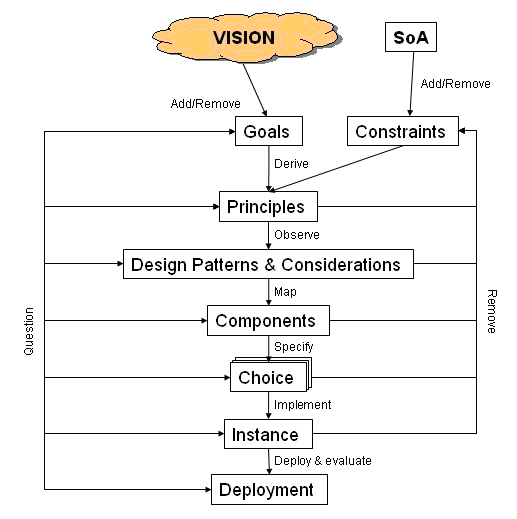






Design Approach
PSIRP is an architecture design project and therefore establishes a highly structured design process that will allow for achieving our ambitious mission. Our approach, as a combination of bottom-up work and top-down rationalization, leads to the following methodology for our architecture design, illustrated in the figure below.

Architecture design process
The design begins with a state-of-the-art (SoA) survey, where advanced current and proposed technologies and solutions are studied. This early phase produces the terminology used in the project, a taxonomy of proposed solutions, and an analysis of key scientific papers, all of which will serve as fundamental building-blocks to sustain the project's future prospects.
Our intention of following a “clean-slate” design approach can be recognized by the formulation of a clear vision (one which is larger than the scope of the project) and the definition of goals for our design. We then follow suit by clearly outlining the principles for our design from which we derive design considerations and patterns to be seen throughout the overall system. This will lead us to a conceptual architecture and its components, to be mapped onto (several) design choices to be implemented and evaluated against the particular requirements derived from the governing principles of our design.
While this approach seems rather top-down and sequential, one can recognize the intention to permanently adapt the design process by virtue of allowing any step of the design to be questioned, leading to refinements at any level. This questioning indicates the integration of a bottom-up approach that will guide our daily work on the particular choices we make.
Based on this design methodology, the project will incrementally develop a complete toolbox of protocols and two working proof-of-concept implementations of the proposed architecture:
-
An evolutionary approach, where pub/sub is run as an overlay on top of IP, and
-
A revolutionary clean-slate approach, where the Internet’s lower layers are fully redesigned.
The architecture and its implementation will be validated by a “Red Team” whose primary tasks involve testing the implementation with real applications under real-world operating scenarios, as well as trying to “break” it by subjecting it to DoS and other types of attacks. Moreover, the economic drivers and socio-economic implications of the new architecture will be investigated.
The experiences gained from the validation process will be used to improve the design and implementation in an iterative fashion, leading to a final solution which embodies the best combination of refinement, reliability, security, and performance.